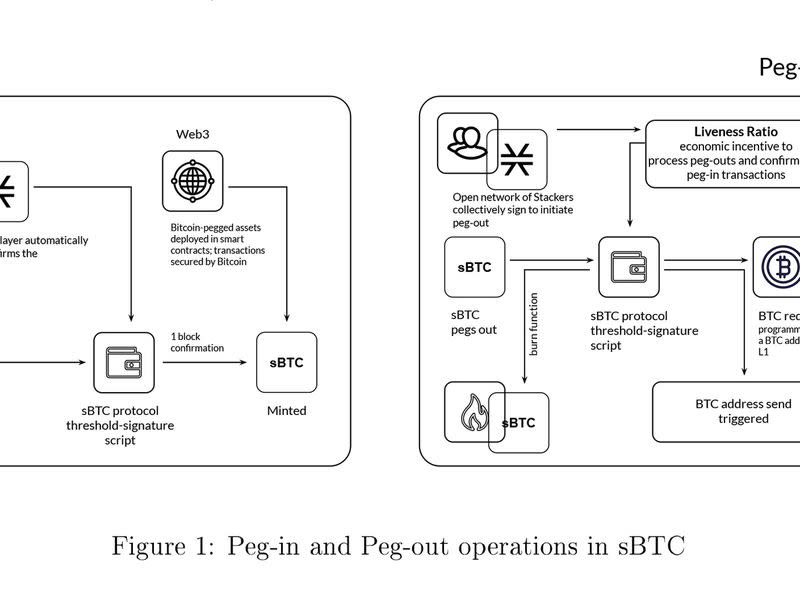Blockchain Project Stacks wants to bring smart contracts to Bitcoin

Blockchain project Stacks has published a whitepaper showing how a new digital resource called “Stacks bitcoin” (sBTC) can be used to make Bitcoin fully programmable.
Unlike Ethereum or Solana where developers can conjure up all sorts of algorithmic machinery—think six-digit gorilla avatars—Bitcoin’s simpler scripting language limits what Bitcoin developers can create on the platform.
Stacks, an existing smart contract platform, wants to break through these limitations by introducing a new digital asset derived from bitcoin – sBTC (pegged 1:1 with bitcoin) – which can be used to create smart contracts on Stacks, but which can also easily converted back to bitcoin (BTC).
“Bitcoin is, by design, relatively slow and does not naturally provide the fully expressive smart
contracts needed to build sophisticated applications,” the white paper says. – Faster and more sophisticated applications must therefore be built outside the foundation. Bitcoin teams make this possible.”
Read more: Smart contract platforms: past, present and future
The term “layer” is Stacks’ lingo for any system outside of Bitcoin’s base layer, such as a sidechain, which is a secondary blockchain that interacts with a primary blockchain. In the white paper, Stacks functions as a Bitcoin sidechain, powered by both sBTC and STX – Stacks’ native token.
The project claims in its white paper that the Bitcoin sidechain could unlock “hundreds of billions of dollars” in DeFi on Bitcoin.
The concept is still in the implementation phase and will be formalized under Stack’s Improvement Proposal (SIP) 21, according to Stack’s co-founder, Muneeb Ali.
“The vote passed and the implementation has started,” Ali confirmed during an interview with CoinDesk. “This is going to be the next big release. My best guess is maybe eight to nine months from now.”
How sBTC works
The current Stacks protocol uses a consensus mechanism (how computers agree on the state of a network) called “proof of transfer”, where anyone can be a miner or “stacker”.
Miners earn STX rewards for mining Stacks blocks, but must first post bitcoin to earn mining privileges. That bitcoin is then distributed as a reward to stackers who maintain a copy of the stacker’s ledger; stackers must also unlock STX for a certain amount of time to receive stacking privileges.
In the proposed sBTC pin system, users send regular bitcoin to a wallet controlled by stackers (a process referred to as “plugging in”). This action creates a corresponding number of sBTC that can be used in smart contracts on Stacks.
To get bitcoin back (“pin out”), users return sBTC to their wallet. Stackers then sign these disconnect requests and release the corresponding amount of bitcoin back to users. This also asks the Stacks protocol to burn the corresponding sBTC.
“It is a completely trustless system. It is a protocol, says Ali. “It’s a dynamic set of signatories who have financial incentives to be signatories and they sign the link transactions.”

Side chain smörgåsbord
Bitcoin sidechains are not new. Blockstream, a Bitcoin infrastructure company, published a whitepaper on sidechains as early as 2014, and currently has a fully functional sidechain federation called Liquid.
Earlier this month, Layer 2 Labs raised a $3 million seed round from angel investors to develop “drivechains,” another variant of Bitcoin sidechains.
Read more: Bitcoin Development Company Layer 2 Labs Raises $3M to Bring Drivechains to the Network
In addition, Bitcoin developer Ruben Somsen has been working on “space chains”, which he describes as “one-way connected side chains for Bitcoin”.
So what new innovation does sBTC bring to the sidechain conversation? Ali claims that the sBTC model is unique in that anyone can be a miner or stacker. He sees the use of STX to incentivize stackers to log out requests as a clear advantage, although alternative projects tend to avoid the use of altcoins like STX like the plague.
“It’s a trade-off,” Ali explains. “The trade-off you make with Liquid is that users have to trust Blockstream and friends – the federation. On Stacks, because it’s extra [STX] token, there is no company in the middle. So you can choose one; you can’t have both.”

























